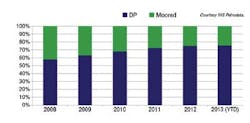Cinnamon Odell
IHS Petrodata
The world's deepwater (>3,000 ft, or 914 m) drilling rig fleet continues to grow in order to meet operators' increasing demands for rigs capable of drilling wells to deeper depths, operating in ever greater water depths, and having them equipped with the newest technologies and safety features. However, the demand for deepwater rigs in general is currently strong enough to keep the older units working for the time being, even though some operators are showing a preference for newer units. As a matter of fact, the only deepwater rig to be removed from the drilling fleet in the past 20 years is theDeepwater Horizon, which sank in the April 2010 Macondo accident in the US Gulf of Mexico.
The global supply of deepwater rigs has more than doubled over the last 10 years, growing from 86 in May 2003 to 107 in May 2008, and reaching 204 units as of May 2013. Of the 204 current deepwater units, 112 are labeled as ultra-deepwater (>7,500 ft, or 2,286 m). This is up from 28 ultra-deepwater units just five years ago. In addition, more deepwater units are presently under construction or on order with shipyards, which will further increase the global supply once they are delivered over the next several years.
Despite the influx of new units, deepwater drilling rig utilization remains at high levels. For the full year 2003, total contracted utilization was 87.3%. This figure rose each year thereafter through 2008, when it reached 99.1%. Since then, total contracted utilization has not dropped below 94%. 2013 is on target to maintain this trend, coming in at 94.1% through the end of May.
Narrowing the discussion to the ultra-deepwater rig fleet, this trend of absorbing additional units while maintaining high contracted utilization is even more apparent. Full-year 2003 contracted utilization was 97.7%, and it has remained above 97% ever since. Notably, in both 2007 and 2008, total contracted utilization averaged 100% for the entire year. Last year came in at 99.3%, and the average so far this year is 99.1%, clearly demonstrating operators' desire for ultra-deepwater units.
Looking at the makeup of the entire deepwater rig fleet, a substantial change has taken effect in several key specifications, such as rated water depth and dynamic positioning (DP) capability. In 2008, approximately 73.8% of the fleet was rated for between 3,001 and 7,500 ft of water, with the remaining 26.2% comprising the ultra-deepwater segment.
Fast-forward to 2013, and the proportions have shifted to 45.1% for rigs rated for 3,001-7,500 ft of water and 54.9% ultra-deepwater. This trend is also expected to continue, even though it does not actually follow that chartering deeper-rated rigs means operators are drilling in deeper water depths. While some deepwater drilling is taking place in over 7,500 ft of water, the majority of wells are still being drilled in less than ultra-deepwater depths.
Additionally, the gap between rigs with DP capability versus those that are conventionally moored continues to widen. Five years ago, 57.8% of the deepwater fleet had DP capability, while 75.3% of today's fleet is identified as DP. In some regions, such as those in the potential path of hurricanes or typhoons, having DP units is preferable to moored units, as the time needed to move the rig out of harm's way is much shorter. However, in certain other regions, such as harsh environment locations like the North Sea, moored units are preferred due to the shallower water depths, and because sea conditions place extra stress on the DP system's station-keeping ability.
Organized by rig manager, Transocean is by far the largest for deepwater rigs, with 48 units. Next come Ensco and Noble Corp. with 21 each, followed by Diamond Offshore with 19 and Seadrill with 13. Ensco, Noble and Diamond each added one net deepwater unit to their fleets over the past year. In all, 30 managers are currently active in the worldwide deepwater rig market. While the longer-term trend has been for the number of deepwater players to increase, the figure actually went down by one earlier this year when Songa Offshore sold its only deepwater unit, semiSonga Eclipse, to Seadrill. Songa is now purely a mid-water player, with nine rigs, four of which are under construction or on order.
In terms of regions, the so-called "Golden Triangle" of deepwater activity, which comprises the US Gulf of Mexico, West Africa, and South America (namely Brazil), is facing some competition for the drilling rig supply from emerging deepwater markets in other parts of the world. While just over 70% of the current deepwater rig supply is in one of those three regions, other areas are also being targeted as potential candidates for some of the new units still under construction or on order at shipyards.
Northwest Europe has 13 deepwater units at present, and Southeast Asia is not far behind with 11. An up-and-coming deepwater market is Australia, which currently has eight units. BP recently awarded a three-year program to Diamond Offshore for a newbuild semi to work off Australia, with a projected delivery date in late 2015.
Another significant market is the Indian Ocean, where a number of east African countries have seen some discoveries over the past few years. This has led to a recent push to bring additional rigs to the area to appraise these finds, as well as to conduct additional exploration work. Multiple operators are believed to be considering future drilling programs off Kenya, Madagascar, Mozambique, and Tanzania. As the resource potential begins to become clearer, more east African countries may end up being added to the deepwater hot spot list in the years to come.




